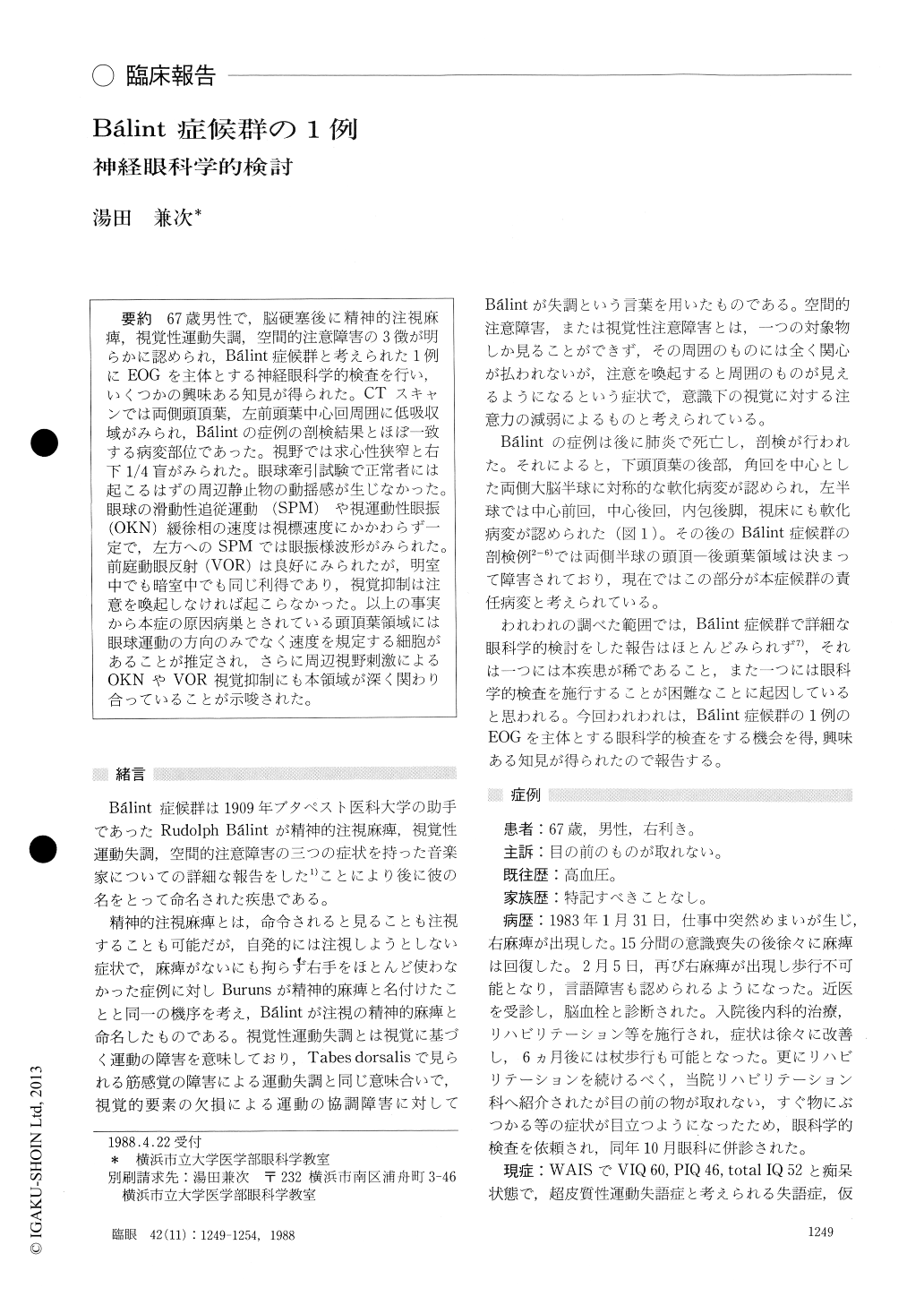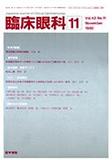Japanese
English
- 有料閲覧
- Abstract 文献概要
- 1ページ目 Look Inside
67歳男性で,脳硬塞後に精神的注視麻痺,視覚性運動失調,空間的注意障害の3徴が明らかに認められ,Bálint症候群と考えられた1例にEOGを主体とする神経眼科学的検査を行い,いくつかの興味ある知見が得られた.CTスキャンでは両側頭頂葉,左前頭葉中心回周囲に低吸収域がみられ,Bálintの症例の剖検結果とほぼ一致する病変部位であった.視野では求心性狭窄と右下1/4盲がみられた.眼球牽引試験で正常者には起こるはずの周辺静止物の動揺感が生じなかった.眼球の滑動性追従運動(SPM)や視運動性眼振(OKN)緩徐相の速度は視標速度にかかわらず一定で,左方へのSPMでは眼振様波形がみられた.前庭動眼反射(VOR)は良好にみられたが,明室中でも暗室中でも同じ利得であり,視覚抑制は注意を喚起しなければ起こらなかった.以上の事実から本症の原因病巣とされている頭頂葉領域には眼球運動の方向のみでなく速度を規定する細胞があることが推定され,さらに周辺視野刺激によるOKNやVOR視覚抑制にも本領域が深く関わり合っていることが示唆された.
A 67-year-old right-handed male manifested Bálint's syndrome after recovering from an attack of cerebral infarction. The clinical manifestations included psychic paralysis of visual perception, optic ataxia and disturbance of visual attention. Computed tomography showed low-density areas in the lower parietal and occipital lobes of both cerebral hemispheres, in addition to low-density areas surrounding the central sulcus of the left cerebral hemisphere.
The visual acuity was 0.4 each. Perimetry showed homonymous lower right quandrantanopsia with concentric contraction. He behaved like a bling person and could not reach visible objects. Forced traction of the eyes induced no sense of motion of surroundings. This seemed to mean that the coor-dinating system of the visual space of the patient was destroyed by the cerebral infarction. He could turn his eyes to all directions responding to oral command but failed to visually induce saccadic eye movements in any direction. Smooth pursuit move-ment of the eyes could be induced only when the visual targets were moved very slowly. By EOG, thevelocity of smooth pursuit eye movement in the right direction was constant irrespective of the velocity of the moving object. Left-beat nystagmus instead of smooth pursuit movement was elicited when the eyes trucked the target in the left direc-tion. The finding seemed to imply that the cells responsible for the velocity and direction of eye movement existed on both parietal lobes. The optokinetic nystagmus (OKN) was asym-metric. The rightward OKN was of small ampli-tude and the leftward one was of large amplitude. The velocities of slow phase OKN and of smooth pursuit movement were constant in either direction independent of target velocity. Vestibulo-ocular reflex (VOR) was induced normally. Visual sup-pression of VOR was absent due to inattention to the visual target.
These findings suggested that the visual suppres-sion, which is believed to be induced by coordina-tion of the secondary visual system and the cerebel-lum, is influenced by the higher-level center in the brain, particularly the parietal lobes.
Rinsho Ganka (Jpn J Clin Ophthalmol) 42(11) : 1249-1254, 1988

Copyright © 1988, Igaku-Shoin Ltd. All rights reserved.


